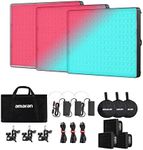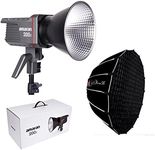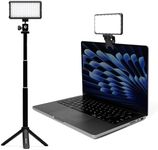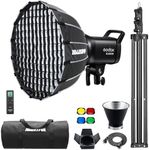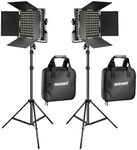Buying Guide for the Best Video Lighting Kits
Choosing the right video lighting kit is crucial for achieving professional-quality video content. Good lighting can make a significant difference in the appearance of your videos, enhancing clarity, color accuracy, and overall production value. When selecting a video lighting kit, it's important to consider several key specifications to ensure you get the best fit for your needs. Here are the main specs to focus on and how to navigate them.Light TypeThe type of light in a video lighting kit can vary, including options like LED, fluorescent, and tungsten lights. LED lights are popular due to their energy efficiency, long lifespan, and adjustable color temperatures. Fluorescent lights provide soft, even lighting and are often used in studio settings. Tungsten lights offer a warm color temperature but can get very hot and consume more power. Choose LED lights for versatility and efficiency, fluorescent for soft studio lighting, and tungsten if you need warm, consistent light.
Color TemperatureColor temperature is measured in Kelvin (K) and indicates the color of the light. Lower values (around 3200K) produce a warm, yellowish light, while higher values (around 5600K) produce a cool, bluish light. Adjustable color temperature lights allow you to match the lighting to different environments and achieve the desired mood. For most users, lights with adjustable color temperature are ideal as they offer flexibility for various shooting conditions.
Brightness (Lumens)Brightness, measured in lumens, determines how much light the kit can produce. Higher lumens mean brighter light. For small indoor setups, 1000-2000 lumens may be sufficient, while larger spaces or outdoor shoots may require 3000 lumens or more. Consider the size of your shooting area and the amount of natural light available when choosing the brightness level. Adjustable brightness settings can provide more control over your lighting.
CRI (Color Rendering Index)CRI measures the ability of a light source to reveal the true colors of objects compared to natural light. A higher CRI (close to 100) means better color accuracy. For video production, a CRI of 90 or above is recommended to ensure that colors appear natural and vibrant on camera. If color accuracy is critical for your work, prioritize lights with a high CRI.
PortabilityPortability refers to how easy it is to transport and set up the lighting kit. Portable kits are lightweight, compact, and often come with carrying cases. If you frequently shoot on location or need to move your setup often, a portable lighting kit is essential. For studio-based work, portability may be less of a concern, and you can opt for more robust, stationary lights.
Power SourceVideo lighting kits can be powered by AC adapters, batteries, or both. AC-powered lights are suitable for studio use where power outlets are readily available. Battery-powered lights offer greater flexibility for outdoor or on-the-go shoots. Some kits provide both options, giving you the versatility to switch between power sources as needed. Choose based on where you plan to use the lights most frequently.
Light ModifiersLight modifiers, such as softboxes, diffusers, and reflectors, help control the quality and direction of light. Softboxes and diffusers soften the light, reducing harsh shadows, while reflectors can bounce light to fill in shadows. Consider what types of light modifiers are included in the kit and how they can enhance your lighting setup. For more control over your lighting, look for kits with a variety of modifiers.

